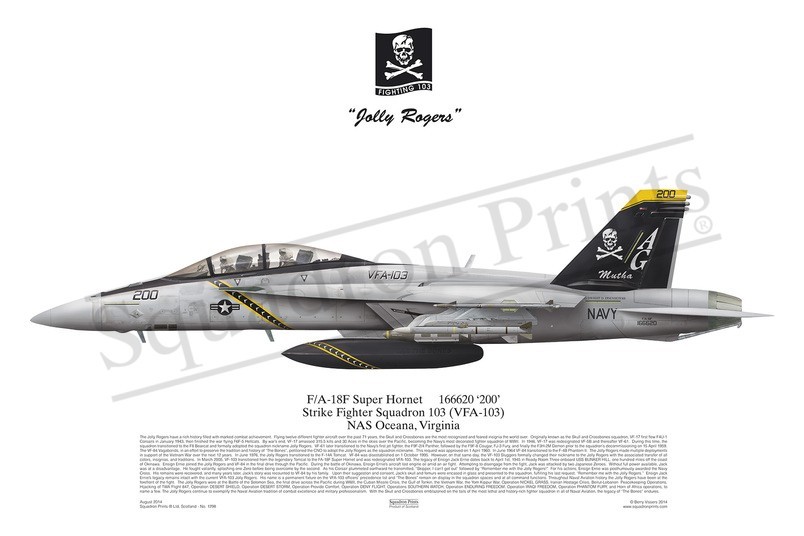#1298 FA-18F Super Hornet

Purchased products will not feature the Squadron Prints watermark
Description
Squadron Prints Lithograph No. 1298 - F/A-18F Super Hornet, 166620 \'200\', Strike Fighter Squadron 103 (VFA-103), NAS Oceana, Virginia.
The Jolly Rogers have a rich history filled with marked combat achievement. Flying twelve different fighter aircraft over the past 71 years, the Skull and Crossbones are the most recognized and feared insignia the world over. Originally known as the Skull and Crossbones squadron, VF-17 first flew F4U-1 Corsairs in January 1943, then finished the war flying F6F-5 Hellcats. By war’s end, VF-17 amassed 315.5 kills and 30 Aces in the skies over the Pacific, becoming the Navy’s most decorated fighter squadron of WWII. In 1946, VF-17 was redesignated VF-5B and thereafter VF-61. During this time, the squadron transitioned to the F8 Bearcat and formally adopted the squadron nickname Jolly Rogers. VF-61 later transitioned to the Navy’s first jet fighter, the F9F-2/4 Panther, followed by the F9F-8 Cougar, FJ-3 Fury, and finally the F3H-2M Demon prior to the squadron’s decommissioning on 15 April 1959. The VF-84 Vagabonds, in an effort to preserve the tradition and history of “The Bones”, petitioned the CNO to adopt the Jolly Rogers as the squadron nickname. This request was approved on 1 April 1960. In June 1964 VF-84 transitioned to the F-4B Phantom II. The Jolly Rogers made multiple deployments in support of the Vietnam War over the next 12 years. In June 1976, the Jolly Rogers transitioned to the F-14A Tomcat. VF-84 was disestablished on 1 October 1995. However, on that same day, the VF-103 Sluggers formally changed their nickname to the Jolly Rogers with the associated transfer of all colors, insignias, and traditions. In March 2005, VF-103 transitioned from the legendary Tomcat to the FA-18F Super Hornet and was redesignated VFA-103. The legacy of Ensign Jack Ernie dates back to April 1st, 1945 in Ready Room Three onboard USS BUNKER HILL, one hundred miles off the coast of Okinawa. Ensign Ernie joined the Jolly Rogers and VF-84 in the final drive through the Pacific. During the battle of Okinawa, Ensign Ernie’s aircraft lost engine oil amid an air fight. Attempting to disengage from the fight, Jack was attacked by two Japanese Zeroes. Without full power available, Jack was at a disadvantage. He fought valiantly, splashing one Zero before being overcome by the second. As his Corsair plummeted earthward he transmitted, “Skipper, I can’t get out” followed by “Remember me with the Jolly Rogers!” For his actions, Ensign Ernie was posthumously awarded the Navy Cross. His remains were recovered, and many years later, Jack’s story was recounted to VF-84 by his family. Upon their suggestion and consent, Jack’s skull and femurs were encased in glass and presented to the squadron, fulfilling his last request, “Remember me with the Jolly Rogers.” Ensign Jack Ernie’s legacy remains intact with the current VFA-103 Jolly Rogers. His name is a permanent fixture on the VFA-103 officers’ precedence list and “The Bones” remain on display in the squadron spaces and at all command functions. Throughout Naval Aviation history the Jolly Rogers have been at the forefront of the fight. The Jolly Rogers were at the Battle of the Solomon Sea, the final drive across the Pacific during WWII, the Cuban Missile Crisis, the Gulf of Tonkin, the Vietnam War, the Yom Kippur War, Operation NICKEL GRASS, Iranian Hostage Crisis, Beirut-Lebanon Peacekeeping Operations, Hijacking of TWA Flight 847, Operation DESERT SHIELD, Operation DESERT STORM, Operation Provide Comfort, Operation DENY FLIGHT, Operations SOUTHERN WATCH, Operation ENDURING FREEDOM, Operation IRAQI FREEDOM, Operation PHANTOM FURY, and Horn of Africa operations, to name a few. The Jolly Rogers continue to exemplify the Naval Aviation tradition of combat excellence and military professionalism. With the Skull and Crossbones emblazoned on the tails of the most lethal and history-rich fighter squadron in all of Naval Aviation, the legacy of “The Bones” endures.
